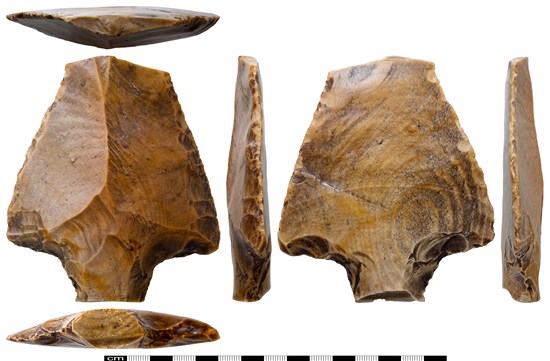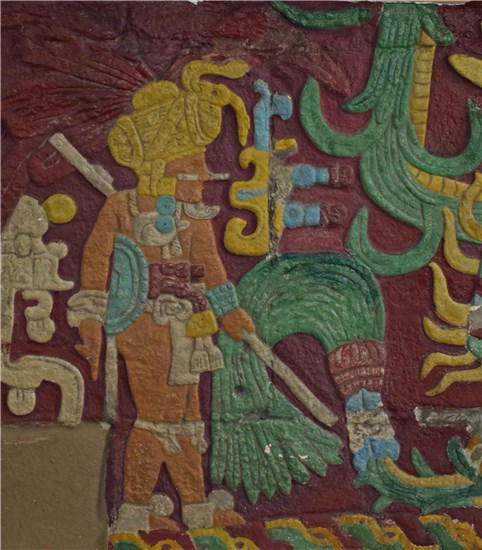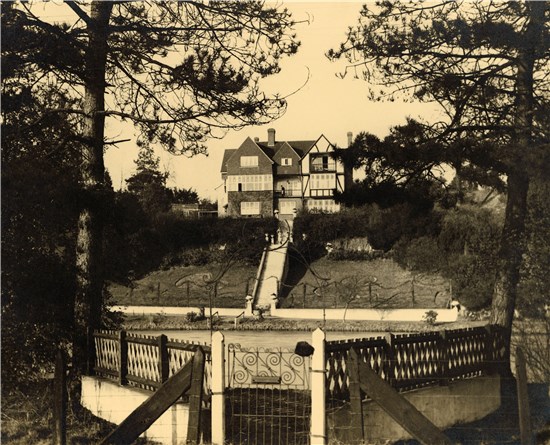It’s not often the Norfolk County Council Find Team are left scratching their collective heads over a discovery. But this very unusual object, found at Brundall, was one of them.

Stone tool: a Mayan chert stemmed macro blade. (© Norfolk County Council).
The first thing to say is that it isn’t a handaxe or a giant arrowhead. Its actual technical name is a ‘stemmed macro blade’, but it’s easier to think of it as a large handheld knife, or a stone dagger. But it’s unlike anything else that’s ever been found in Norfolk: the shape’s wrong, the size is wrong and that stone looks nothing like our own famous and very distinctive black and grey flint.
So what is it – and where did it originally come from?
I mentioned we were scratching our heads. And so were until our flint specialist Jason Gibbons stepped in. There was something about the object’s heft (it’s almost 11cm long, and was once much bigger), the way it had been worked and the colour of the stone which seemed instantly familiar to him. His answer was truly astonishing: this object wasn’t made in Norfolk at all, but 5,250 miles away in Belize in Central America. And the people who made it were one of the most famous from history – the once-extensive 'Maya' civilisation, which survived until the fateful encounters with colonising Spanish conquistadores in the 16th century.

Ancient culture: A painted plaster cast of a Mayan sculpture from Chichén Itzá, Lower Temple of the Jaguars. (© The Trustees of the British Museum).
Jason takes up the story: ‘I could see it was made from a massive struck blade, there are a few cultures that make them (we made long blades in the Upper Palaeolithic, 40,000 to 10,000 BC) but nowhere remotely near that big, apart from only one culture, and that is in Belize, so it was narrowed down very quickly.’ This stone is known as Colha chert, and is found in abundance in the north-east central area of the country, formerly known as ‘British Honduras’.
He adds: ‘I studied these back around 2012 along with trying to familiarise myself with both North and South American worked flints and flint types. I’m still working on that as there are thousands of variations.’
This type of tool was used for more than 1000 years, from circa 250 BC to AD 900. This example is a little battered, having lost its point and handle. It would have been used as a large knife or dagger.
‘They were also used by the "elite" class of Maya society in ritual caches,’ Jason says, ‘the favoured deposition of which appears to be in rivers.’
So that’s the object identified. But how on earth did it arrive in the Broads?
The tool was actually found in the 1950s, from the surface very near to Brundall Gardens. This was a popular tourist attraction founded in the 1880s, its attractive slopes giving rise to the nickname of ‘Little Switzerland’. The name of the attraction lives on in Brundall Gardens station. An old map shows the gardens once had a small museum. Was this Mayan tool one of the exhibits perhaps, a curiosity accidentally dropped and then lost one day? Decades after its rediscovery it was brought to Norwich Metal Detecting Club for identification and recording by the present owner.

Beauty spot: Brundall Gardens, pictured in the 1920s. (Image courtesy of www.picture.norfolk.gov.uk)
We may never truly know how it came to Brundall in the first place, although Jason has an interesting theory about that. You can find out what it is – and more about the story behind this fascinating object – by visiting the full record on the Portable Antiquities Scheme database under NMS-E80743.